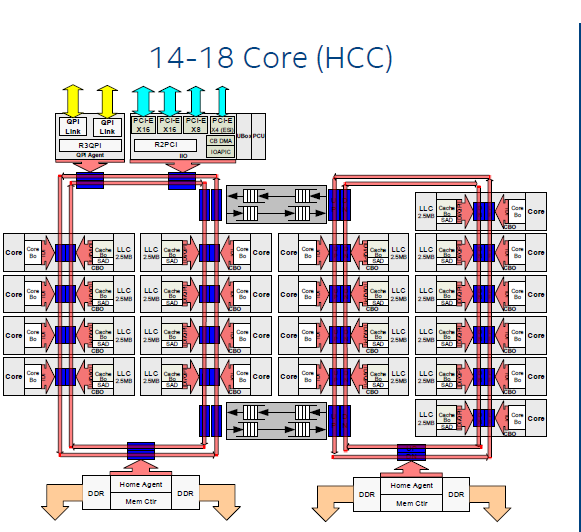The Intel Xeon E7-8800 v3 Review: The POWER8 Killer?
by Johan De Gelas on May 8, 2015 8:00 AM EST- Posted in
- CPUs
- IT Computing
- Intel
- Xeon
- Haswell
- Enterprise
- server
- Enterprise CPUs
- POWER
- POWER8
The New Xeon E7v3: The Same Xeon Haswell-EP Die...
The "new" Xeon E7 is basically the same Haswell EP die that we talked about in the our Xeon E5 reviews. Spot the only difference between the Haswell EP,
and the Haswell EX die:
Indeed, a third QPI link which allows an 8-socket configuration without any special glue logic. The transistor count is the same (5.69 Billion) and that is also true for the massive die size (662 mm²).












146 Comments
View All Comments
PowerTrumps - Saturday, May 9, 2015 - link
Oracle has been unable to develop a power core let alone a processor. What they have done is created servers with many cores and many threads albeit weak cores/threads. The S3 core was an improvement and no reason to think the S4 won't be decent either. However, the M7 will come (again, true to form) with 32 cores per socket. It will be like 8 mini clusters of 4 cores because they are unable to develop a single SMP chip with shared resources across all of the cores. As such, these mini clusters will have their own resources which will lead to latency and inefficiencies. Oracle is a software business and their goal is to run software on either the most cores possible or the most inefficient. They have both of these bases covered with their Intel and SPARC business.Also, performance per Watt is important for Intel because what you see is what you get. With Power though, when you have strong single thread performance, strong multi-thread performance and tremendous consolidation efficiency due to Power Hypervisor efficiency means ~200W doesn't matter when you can consolidate 2, 4 maybe 10 Intel chips at 135W each into a single Power chip because of this hypervisor efficiency.
tynopik - Friday, May 8, 2015 - link
pg4 - datam iningder - Friday, May 8, 2015 - link
Woo...we're bout to have another GHz War here!usernametaken76 - Friday, May 8, 2015 - link
I'm sure you mean figuratively. We've been stuck between 4-5 GHz on POWER architecture for closing in on a decade.zamroni - Friday, May 8, 2015 - link
My conclusion is Samsung should buy AMD to reduce Intel dominance.alpha754293 - Friday, May 8, 2015 - link
It would have been interesting to see the LS-DYNA benchmark results again (so that you can compare it against some of the tests that you've ran previously). But very interesting...JohanAnandtech - Friday, May 8, 2015 - link
Give me some help and we'll do that again on an update version :-)alpha754293 - Tuesday, May 12, 2015 - link
Not a problem. You have my email address right? And if not, I'll just send you another email and we can get that going again. :) Thanks.andychow - Friday, May 8, 2015 - link
If Samsung bought AMD, they would lose the licence for both x86 and x86_64 production. It would in fact ensure Intel's dominance of the market.Kevin G - Friday, May 8, 2015 - link
The x86 license can be transferred as long as Intel signs off on the deal (and it is in their best interest to do so). What will probably happen is that if any company buys AMD, the new owner will enter a cross licensing agreement with Intel.